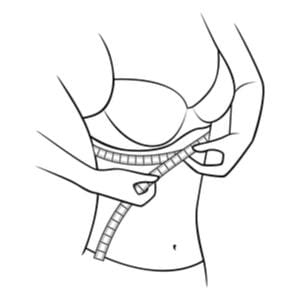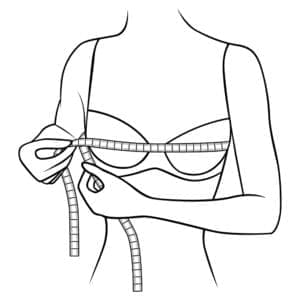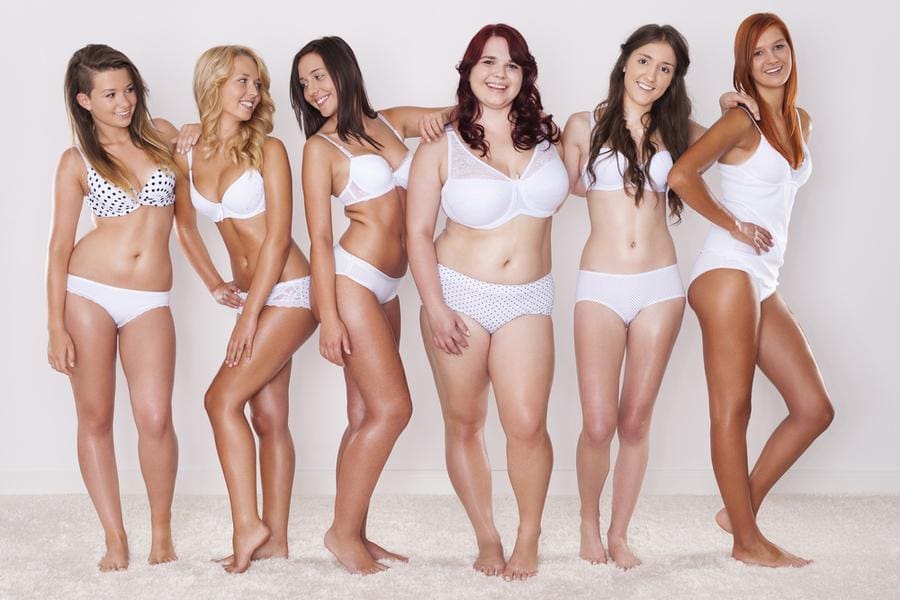More often than not, women don’t get professionally measured to determine their accurate bra size. This means that most women use the average guess and check method, which is most likely results in inaccurate results or discomfort. So how do you determine your bra size? These pointers will provide you with an easy way to get accurate results that will improve your comfort.
Measure Directly Under the Bust for the Band Size
The common misconception here is that when you measure under your bust, the resulting number is your band size. This is false! For example, if your under-bust measurement falls between 30 and 32 inches, your band size is actually 36. *(We will give that explanation below).

So how do you measure band size?
For best results, you should be wearing no bra (or a bra with very light lining), as you’ll be measuring around the entire diameter of your body, directly underneath your bust. Make sure you keep the measuring tape snug to your body without pulling it too tight, as this will result in the wrong measurement and lead to an uncomfortable bra selection. Pro tip here: do not round that number up! Instead, you will need to round down to the closest even number. So if you measured 35.4 inches, you’d want to round down to 34 inches, not up to 36 inches.
*If you measured 24 to 26 inches in a standard sizing chart, your band size is 30. If you measured 26 to 28 inches, your band size is 32. If you measured 28 to 30 inches, your band size is 34. If you measured 30 to 32 inches, your band size is 36. If you measured 32 to 34 inches, your band size is 38. If you measured 34 to 36 inches, your band size is 40.

Measure Your Full Chest for Your Bust Size
No, cup size is not a guess, or based on how full your breasts look. Instead, there is an actual measurement associated with every cup size, and it can look pretty intimidating on most sizing charts, so we’ll break it all down right here.
First of all, as mentioned above, you’ll want to either measure your breasts without a bra on or wear a bra with minimal (or ideally no) padding. The reason for this is that you will measure the diameter of your breasts at their fullest point, so if there’s padding, you’ll get an inaccurate measurement.
Again, you’ll want to make sure the measuring tape is snug but not too tight for optimal comfort. A trick is to breathe a few times deeply to allow the measuring tape to loosen a natural degree before you read the measurement.
On this one, you’ll want to follow standard rounding rules, so for a half-inch measurement and up, round up to the nearest inch, and anything underneath, you can round down to the nearest inch.
Get Familiar with Simple Math for your Cup Size
That’s right ladies, unfortunately, determining bra size is math dependent, though luckily, it just involves some simple subtraction. Take the band size you first calculated and subtract it from the bust size that you calculated second, and the number you end up with is your accurate cup size.
To provide you with the standard sizing information based on this mathematical equation, a difference of 1 inch means you are an A cup; a difference of 2 inches means you’re a B cup; a difference of 3 inches means you’re a C cup; a difference of 4 inches means you’re a D cup; a difference of 5 inches means you’re a DD cup; a difference of 6 inches means you’re a DDD.
From here, you will combine your band size with your newly calculated cup size, and voila! You are now a bra sizing expert. Just note that bra size (like any other clothing size) might vary depending upon the brand, so always compare your measurements against the size charts provided by the manufacturer on their website to be sure you’re purchasing the correct size for your measurements.
With these quick tips and tricks in your corner, the days of discomfort are behind you, and the right bra is finally within your grasp!






